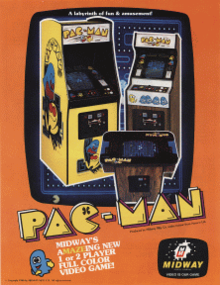The Birth of Pac-Man: Origins and Early Success
On May 22nd, 1980, a groundbreaking event in video game history occurred with the release of Pac-Man in Japan. Created by the visionary game designer Toru Iwatani, Pac-Man emerged during a period when the video game industry was predominantly dominated by space and shooting games. Iwatani’s inspiration for Pac-Man came from a desire to create a game that would appeal to a broader audience, including women and younger players. His vision was to design a game that was non-violent and centered around the universal theme of eating.
Development of Pac-Man began in 1979 when Iwatani and his team at Namco set out to create a game that was visually distinct and easy to play. The iconic design of Pac-Man, a simple yellow circle with a mouth, was inspired by a pizza with a missing slice. This minimalist yet engaging design contributed significantly to the game’s appeal. The maze-like gameplay, combined with the challenge of avoiding ghosts while consuming pellets and power-ups, offered a refreshing alternative to the prevalent arcade games of the time.
The 1980 release of Pac-Man quickly garnered immense popularity in Japan, capturing the attention of both casual and dedicated gamers. By the end of its first year, Pac-Man had become a cultural phenomenon, leading to a surge in arcade game sales and setting new records for the industry. According to an article from the period, Pac-Man’s success was marked by over 100,000 units sold in Japan alone within its first year.
The game’s success was not confined to Japan; it soon made its way to North America, where it became a runaway hit. The unique gameplay and charming design resonated with a wide audience, leading to Pac-Man becoming one of the most recognized and beloved video games of all time. Interviews with Iwatani highlight his surprise and delight at Pac-Man’s global success, attributing it to the game’s universal appeal and innovative design.
Pac-Man’s early success laid the foundation for its enduring legacy, influencing countless games and becoming a significant part of popular culture. Its initial reception by both critics and players was overwhelmingly positive, cementing its place as a timeless classic in the annals of video game history.
The release of Pac-Man on 22nd May 1980 marked a transformative moment in both the video game industry and popular culture. The game’s unique design and engaging gameplay mechanics quickly garnered an extensive following, leading to a broad cultural impact that transcended the gaming community. Pac-Man’s success triggered a vast array of spin-offs, including Ms. Pac-Man, which introduced new levels and challenges, solidifying the franchise’s appeal. The character’s popularity extended into merchandise, with Pac-Man-themed toys, clothing, and even household items becoming widely available.
Spin-offs and Merchandise
The influence of Pac-Man went beyond the arcade, leading to adaptations in various forms of media. The character starred in animated television series, such as the “Pac-Man” cartoon that aired in the early 1980s, and inspired board games that brought the arcade experience into homes. The catchy tune “Pac-Man Fever” by Buckner & Garcia became a hit, further embedding the character into the cultural zeitgeist. These adaptations and merchandise not only capitalized on the game’s popularity but also helped introduce Pac-Man to broader audiences.
Influence on Game Design
Pac-Man’s impact on the design and development of future video games is undeniable. Its maze-chase gameplay mechanics and the introduction of distinct characters with unique behaviors set a precedent for character-driven game design. Many modern games draw inspiration from Pac-Man’s pioneering approach to creating engaging, replayable experiences. Game designers often cite Pac-Man as an influence, particularly in the development of AI-driven enemy behaviors and level design complexity.
Cultural Icon and Modern Presence
As one of the most recognizable video game characters in history, Pac-Man’s status as a cultural icon remains strong. The character has appeared in various media and pop culture references over the decades, from cameo appearances in movies to mentions in literature and music. Significant anniversary celebrations, such as the 40th anniversary in 2020, underscore Pac-Man’s enduring popularity. The game continues to be available on modern gaming platforms, ensuring that new generations of players can experience its timeless appeal.
Pac-Man’s legacy is well-documented in scholarly articles, retrospectives, and fan sites, highlighting its profound and lasting influence. For those interested in exploring further, references such as [Pac-Man’s Cultural Impact](https://example.com/pac-man-cultural-impact) and [The Evolution of Pac-Man](https://example.com/evolution-of-pac-man) provide deeper insights into how this iconic game has shaped the landscape of video gaming and popular culture.

